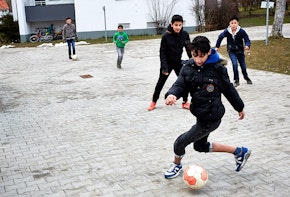Over the past decade, health care policy has become increasingly central to American politics. The passage of the Affordable Care Act (ACA), and the numerous attempts to expand it, repeal it, replace it, or sabotage it have dominated conversations in Washington, D.C. The American public gets the opportunity to participate in this debate by electing representatives that will steer health care policy according to their views.
But as so often happens, these political outcomes can easily be affected by participation bias; that is, election results might not represent the American electorate accurately, because the core of people who actually vote may hold views that diverge from those of the majority. And in fact, there is increasing evidence that barriers to voter registration in particular are powerful impediments to implementation of equitable health policy. Nothing illustrates this divergence between public policy and the public’s views better than the case of Medicaid expansion.
Figure 1, generated by Data for Progress co-founder Colin McAuliffe, shows that, in many states, there are large racial disparities in views toward the Medicaid expansion option that is part of the ACA, and that these divergences are widest in Southern states.1 In Massachusetts, white support for the Medicaid expansion is 13 percentage points lower than black support; in Georgia, this gap is 32 percentage points. On average, in expansion states, 37 percent of whites oppose expansion, compared with 47 percent in non-expansion states. In expansion states, the white–black gap in support for Medicaid expansion is 18 points, compared with 23 points in non-expansion states.
Research suggests that these racial disparities in public opinion can explain the differential implementation of the Medicaid expansion.2 In states that have registration barriers and other barriers to voting that disproportionately affect people of color, these could reduce the chances of Medicaid expansion passage. One study, examining the potential of Medicaid expansion in Alabama, found that a stunning two-thirds of the beneficiaries of Medicaid expansion were not registered to vote.3 Political scientist Julie Pacheco has documented that politicians are more responsive to healthier constituents than less-healthy constituents due to inequalities in political participation.4 In another study, she finds that state-level bias in turnout by health status is associated with less generous Medicaid programs.5
Figure 1
Source: Generated by Data for Progress, using data from the Cooperative Congressional Election Studies 2014 Survey.
This divergence in Medicaid expansion along voter participation lines is troubling in itself, but it is part of a larger problem: policy outcomes, particularly in health care, are not following public preference.
This report explores the ways that registration and other barriers to voting can impact policy, particularly related to the issue of health care. First, it discusses the evidence that voting barriers are not borne equally, but instead introduce biases into the electorate. Second, it shows how health bias in turnout could lead to distorted policymaking. Third, it explores the evidence that expanded access to health care creates positive feedback loops toward full democratic inclusion. Finally, it suggests policy measures that could reduce inequality in representation.
Why Voting Matters
Voter turnout in the United States is lower than in other comparably rich countries.6 Throughout the member countries of the Organization for Economic Co-operation and Development, there is a reasonably strong correlation between voter turnout and levels of social service provision.7 Higher turnout, by creating more inclusive electorates, helps to ensure public policy is inclusive.8 Within the United States, academics have noted the same relationship: states with higher turnout have more government redistribution of income.9
The view that higher turnout is needed to guarantee more equitable policy outcomes has been at odds with another, perhaps more traditional narrative, which argues that voters are a representative sample of the general public, and represent its attitudes. Political scientists Benjamin Highton and Raymond Wolfinger argue that, “simply put, voters’ preferences differ minimally from those of all citizens; outcomes would not change if everyone voted.”10 More recently, however, in Who Votes Now, political scientists Jan Leighley and Jonathan Nagler argue that, in fact, there are indeed growing and significant divergences between voters and non-voters, particularly on issues of class, such as union organizing, guaranteed jobs, and government-provided healthcare.11 This more recent research has focused on the propensity of individuals to vote (rather than their voting behavior in a single election), and has found meaningful preference gaps. Consulting these two perspectives—one focused on policy outcomes, and the other focused on attitudes—leads to a single conclusion: there are real divides between voters and non-voters, and these divides have important implications for policy.
Recent research has increasingly accumulated evidence that (1) habitual voters are not representative of the broad population, and (2) gaps in participation have powerful implications for policy. Take voter pre-registration, a policy that increases turnout among young people by allowing them to register to vote when they get a driver’s license. The research shows why this matters: the passage of pre-registration legislation is associated with, for example, an increase in spending on higher education.12 Additional research finds consistent evidence that income bias in turnout (the extent to which rich people vote at a higher rate than the poor) affects the provision of welfare; one study finds that tighter voter registration deadlines (measured by days before the election an individual is prevented from registering) exacerbate class bias in the electorate, enabling the passage of more punitive welfare eligibility laws.13 Studies also show that the enfranchisement of black voters is associated with reductions in black and white education gaps, as politicians began directing more spending to black localities.14 And, the enfranchisement of women is linked with increased spending on children and lower child mortality.15
Estimating Who Is Disenfranchised by Registration
Given that barriers to registration have a powerful negative effect on turnout, and that who votes influences policy, the demographics of the unregistered-versus-registered population could be biasing policy. Since policymakers respond to voters much more adeptly than to non-voters,16 persistent biases in turnout could make policymaking unrepresentative. Given that registration is the single most important policy barrier to voting,17 it’s worth studying.
The Census Bureau generates estimates of registration, and examining data from the 2016 presidential election provides some interesting evidence. As Figure 2 shows, the registration rate among young people, particularly young people of color, is far lower than that of older individuals. Whites over the age of 65 have a registration rate of 81 percent, compared to a registration rate of 54 percent for people of color aged 18 to 29.18
Figure 2
There are also deep class divides in registration that often intersect with racial gaps. For instance, the registration rate for whites earning more than $50,000 a year is 79 percent, compared with 58 percent among people of color earning less than $50,000.19
Figure 3
Targeting Registration Can Increase Political Participation
Another way to analyze who is disenfranchised by registration is to examine who becomes more likely to vote when a registration barrier is removed. Evidence from Oregon suggests that the implementation of automatic voter registration increased the participation of young people, low-income people, people of color, and also rural voters.20 Political scientists R. Michael Alvarez, Stephen Ansolabehere, and Catherine Wilson find that, had election day-registration been in effect in all states in 2000,
turnout among the 18 to 25 year old group could increase nationally by almost 12%, under national election day registration. National turnout could increase by almost 11% for Hispanics, 12% for Asians and other racial groups, and 7.5% for Blacks. We estimate almost a 10% increase in turnout for those who have moved residences in the past six months, a 9% increase in turnout for non-married citizens, and a 12% for non-natives.21
A recent study documents that this finding is consistent: same-day registration bolsters turnout, particularly among marginalized groups.22 Furthermore, reforms targeting registration barriers, particularly same-day registration, can reduce class bias in turnout.23
Research on different methods to make registration easier have consistently found that these interventions increase turnout. A recent study by political scientists John B. Holbein and D. Sunshine Hillygus finds that pre-registration, which allows young people to “pre-register” to vote when they get their driver’s license, has a powerful impact on turnout, increasing youth voting by somewhere between 2 to 8 percentage points.24 Within the United States, ease of registration has been consistently linked to higher levels of turnout.25 States with same-day registration have consistently higher levels of turnout than states without same-day registration.26
Unequal Political Participation Dampens Democracy
These disparities in turnout have implications for policy. To examine how higher turnout might affect policy in a broad range of areas, I use American National Election Studies (ANES) 2016 data to analyze differences of opinion among voters, non-voters, and the less frequently studied marginal voters, who drift in and out of the electorate. Using the ANES questions on generic government spending, universal health care, the environment, and guaranteed jobs my research shows that consistent voters are the least supportive of an expansive social safety net (ANES asks each question as a 1 to 7 scale, which I re-scaled so that 0 was the most conservative position and 100 was the most liberal position).27 The ANES survey presented two options for the respondent to choose, representing conservative and liberal views (paraphrased as follows):
- Generic spending and services: Some people think the government should provide fewer services even in areas such as health and education in order to reduce spending. Other people feel it is important for the government to provide many more services even if it means an increase in spending.
- Guaranteed jobs: Some people feel the government in Washington should see to it that every person has a job and a good standard of living. Others think the government should just let each person get ahead on their own.
- The environment: Some people think the federal government needs to regulate business to protect the environment. They think that efforts to protect the environment will also create jobs. Others think that the federal government should not regulate business to protect the environment. They think this regulation will not do much to help the environment and will cost us jobs.
- Health care: There is much concern about the rapid rise in medical and hospital costs. Some people feel there should be a government insurance plan which would cover all medical and hospital expenses for everyone. Others feel that all medical expenses should be paid by individuals through private insurance plans like Blue Cross or other company paid plans.
As Figure 4 shows, individuals who vote frequently score lower on the index—on average, about 9 percentage points lower. The gap between non-voters and regular voters is largest on the guaranteed jobs and income scale (14 percentage points) and lowest on the environment scale (5 percentage points).28 That is, individuals who voted in all of federal elections between 2012 and 2016 have significantly more conservative policy views than non-voters and marginal voters. These results are in line with the broader academic literature,29 which finds that ideological gaps between voters and non-voters have grown and are deeply intertwined with issues of class.30 To put this gap in perspective, the difference between non-voters and individuals who voted in one election on the jobs and income scale is equal to the gap between whites and people of color (14 percent).
Figure 4
How Registration Barriers Affect Health Care Policy
There is a consistent health bias in turnout that could have policy consequences. Voters tend to be healthier than non-voters, and non-voters are less likely to be uninsured. According to the ANES survey, the turnout rate among uninsured Americans was 34 percent, compared to a 63 percent turnout rate among those who were insured. Studies also show that people with disabilities turnout at lower rates.31 According to the ANES data, the turnout rate among individuals with “Excellent” or “Very good” health is 64 percent; among those reporting “Fair” or “Poor” health, the voter turnout rate was 49 percent.32
Figure 5
Access to the ballot matters: people who are in poor health or uninsured have different political preferences than those who are in good health or have health insurance. As Figure 6 shows, according to my analysis of ANES data, individuals in good health are more likely support government cuts, while individuals in poor health are more likely to support a more expansive role for government, with 41 percent of those in good health supporting cuts to government spending compared with 30 percent of those in fair or poor health.
Figure 6
On the issue of health spending specifically, people in poor health are eight percentage points more supportive of spending increases than people in excellent or very good health (52 percent to 44 percent; see Figure 7).
Figure 7
People who don’t vote are more supportive of expansions to the safety net, particularly around the issue of health care. To examine attitudes, I categorized each respondent by the number of federal elections between 2012 and 2016 an individual voted in; an individual who voted in none of the elections would be 0, and an individual who voted in all three elections would be a 3. As Figure 8 shows, individuals who voted in three elections were the most supportive of health care cuts (29 percent) and the least supportive of expansions (43 percent) for a net support (increase minus decrease) of 14 points. Among those who voted in no elections, net support for increases was 26 percent, and among those who voted in one or two, net support was 23 percent.
Figure 8
Returning to the example of the Medicaid expansion at this point is illuminating. Most states elect governors in off-cycle elections, which could have particularly important implications for the expansion of Medicaid. A study by political scientist Anthony Fowler finds that, compared to off-cycle gubernatorial elections, on-cycle elections “increase turnout by 17.4 percentage points and the Democratic candidate’s vote share by 6.4 percentage points.”33 Given that governors and state legislatures have significant discretion about the passage of Medicaid expansion, this turnout differential could be determinative. For instance, if Florida’s gubernatorial elections held on-cycle with presidential elections in 2012, rather than during midterms in 2010, it is likely the state would have elected more progressive politicians and expanded Medicaid.
Feedback Loops
Political scientists have begun to document a positive feedback loop from the Medicaid expansion, showing how access to health care can create virtuous cycles of democratic participation. Political scientist Jake Haselswerdt documents that “Medicaid enrollment associated with the expansion are related to considerably higher voter turnout.”34 Political scientists Joshua Clinton and Michael Sances find that “counties in expansion states experience higher political participation compared to otherwise similar counties in non-expansion states.”35
These feedback loops can have multiple causal mechanisms. For instance, backlash from conservatives against the ACA increasing Republican turnout can explain some of this effect, but not all of the effect, because Haselswerdt examines individual level survey data and finds that, “Medicaid recipients with a higher probability of being newly covered in 2014 were more likely to report having voted, all else equal.” Clinton and Sances find that the effect on turnout “is largest in counties with above average poverty levels,” and highlight the possibility that new Medicaid recipients would be offered an opportunity to register to vote due to the National Voter Registration Act (NVRA).
There is also a negative feedback loop in states where Medicaid was not expanded. Political scientists Daniel Hopkins and Kalind Parish find that the Affordable Care Act is more popular among low-income people in expansion states.36 In a more recent study, political scientists Vladimir Kogan and Thomas Wood find that rejecting the Medicaid expansion likely improved the electoral fortunes of the Republican Party.37
Conclusion and Recommendations
In order to reduce biases in turnout and create a more representative electorate, state policymakers should pursue initiatives that ease access to voting and reduce registration barriers. Specifically:
- States should adopt same-day and automatic registration and “pre-register” young people who interact with the state Department of Motor Vehicles or the relevant motor vehicle departments (DMVs). This policy has been proven to increase turnout among young people,38 and has been successfully implemented in more than a dozen states, including Colorado, Utah, Florida and North Carolina.39
- States should make efforts to expand automatic voter registration beyond simply DMVs, wherever the technological capacities exist for that to be possible. While 32 percent of individuals without a disability report registering at a DMV, only 25 percent of individuals with a disability do.40 This is increasingly becoming standard practice with automatic voter registration, and states such as Rhode Island, Washington, and New Jersey that have implemented automatic voter registration have followed this practice.41
- States should make increased efforts to ensure that polling places are disability accessible, which is proven to increase turnout among people with disabilities.42
- States should open access to mail-in voting by establishing no-fault absentee voting or mail-in balloting, a norm in most states.43
- States should ease voting by establishing voter centers, centralized precincts where individuals can vote regardless of their precinct. A study in Colorado suggests this policy increases turnout, particularly among infrequent voters.44
- States should allow for early voting, with registration available at polling places, as is the case in Colorado, Illinois, and Iowa.45
Disparities in turnout create an unrepresentative electorate, biasing policy towards the wealthy and the healthy. States should take more active measures to ensure the interests and preferences of all Americans are represented, not just the able-bodied.
Acknowledgements
The author would like to thank Jake Haselswerdt (assistant professor of political science, University of Missouri), William Franko (assistant professor of political science at West Virginia University) and Jason McDaniel (assistant professor of political science at San Francisco State University) for feedback and input on this report. The author would like to thank Colin McAuliffe, co-founder of Data for Progress, for contributing analysis to this report.
Notes
- McAuliffe used multilevel-regression and poststratification (MRP) to generate the state-level estimates.
- C. M. Grogan and S. E. Park, “The Racial Divide in State Medicaid Expansions,” Journal of Health Politics, Policy, and Law, June 2017, https://www.ncbi.nlm.nih.gov/pubmed/28213393.
- Josh Carpenter and Florian Foos, “Beyond the Submerged State: Exploring the Limits of Policy-Based Mobilization,” draft, August 2016, www.florianfoos.net/resources/Beyond-the-Submerged-State_APSA_2016.-Carpenter-and-Foos.pdf.
- Julianna Pacheco, “A Healthy Democracy? Evidence of Unequal Representation across Health Status,” September 2013, www.juliannapacheco.weebly.com/uploads/1/3/3/7/13371994/a_healthy_democracy_unequal_representation_across_health_status.pdf.
- Julie Pacheco, “The Policy Consequences of Health Bias in Political Voice,” APSA 2014 Annual Meeting Paper, available at https://ssrn.com/abstract=2454900.
- Drew DeSilver, “U.S. trails most developed countries in voter turnout,” May 2017, www.pewresearch.org/fact-tank/2017/05/15/u-s-voter-turnout-trails-most-developed-countries/.
- Lane Kenworthy and Jonas Pontusson, “Rising inequality and the politics of redistribution in affluent countries,” LIS Working Paper Series no. 400, Luxembourg Income Study, January 2005, https://www.econstor.eu/bitstream/10419/95499/1/483132640.pdf.
- Vincent A. Mahler, David K. Jesuit, and Piotr R. Paradowski, “Electoral Turnout and State Redistribution A Cross-National Study of Fourteen Developed Countries,” Political Research Quarterly, November 2013.
- William W. Franko, Nathan J. Kelly and Christopher Witko, “Class Bias in Voter Turnout, Representation, and Income Inequality,” Perspectives on Politics, June 2016, https://www.cambridge.org/core/journals/perspectives-on-politics/article/class-bias-in-voter-turnout-representation-and-income-inequality/4111BEA1EB84C8C0347004ABFBED0C2B.
- Benjamin Highton and Raymond E. Wolfinger, “The Political Implications of Higher Turnout,” British Journal of Political Science, January 2001, http://www.jstor.org/stable/3593280?seq=1#page_scan_tab_contents.
- Jan Leighley and Jonathan Nagler, Who Votes Now: Demographics, Issues, Inequality, and Turnout in the United States (Princeton, N.J.: Princeton University Press, 2013).
- Graziella Bertocchi, Arcangelo Dimico, Francesco Lancia and Alessia Russo, “Youth Enfranchisement, Political Responsiveness, and Education Expenditure: Evidence from the U.S.,” March 2018, http://morgana.unimore.it/bertocchi_graziella/papers/youthweb.pdf.
- James Avery and Mark Peffley, “Voter Registration Requirements, Voter Turnout, and Welfare Eligibility Policy: Class Bias Matters,” State Politics and Policy Quarterly 5, no. 1 (Spring 2005): 47–67, https://www.jstor.org/stable/40421537?seq=1#page_scan_tab_contents.
- Elizabeth Cascio and Ebonya Washington, “Valuing the Vote,” August 2, 2012, https://economics.yale.edu/sites/default/files/files/Faculty/washington/value-the-vote.pdf.
- Grant Miller, “Women’s Suffrage, Political Responsiveness, and Child Survival in American History,” Quarterly Journal of Economics 123, no. 3 (August 2008): 1287–1327, https://www.ncbi.nlm.nih.gov/pmc/articles/PMC3046394/.
- William Franko, Nathan Kelly, and Christopher Witko, “Class Bias in Voter Turnout, Representation, and Income Inequality,” Perspectives on Politics 14, no. 2 (June 2016): 351–68, https://www.cambridge.org/core/journals/perspectives-on-politics/article/class-bias-in-voter-turnout-representation-and-income-inequality/4111BEA1EB84C8C0347004ABFBED0C2B.
- “Not registered” is the most commonly offered policy explanation for not voting among non-voters (that is, not including answers like “didn’t like the candidates”).
- These gaps might be inflated somewhat due to biases in misreporting of registration. These data are collected through a survey, and due to social desirability bias, individuals are more likely to report voting than actually vote. Ansolabehere and Hersh find that a number of important variables influence the likelihood of misreporting registration. Age doesn’t seem to be of primary importance, but, they do find modest differential misreporting across race and class in Census Bureau data. See Stephen Ansolabehere and Eitan Hersh, “Validation: What Big Data Reveal about Survey Misreporting and the Real Electorate,” Political Analysis 20, no. 4 (Autumn 2012): 437–59, http://www.jstor.org/stable/23359641. William Franko also finds that misreporting does not substantively affect conclusions about voting disparities and policy outcomes. See William Franko, “More Equal than We Thought?” State Politics and Policy Quarterly 15, no. 1 (January 2015): 91–114, http://journals.sagepub.com/doi/abs/10.1177/1532440014566740.
- To ensure that these gaps were not merely due to misreporting, I turn to Cooperative Congressional Election Studies (CCES) data. The CCES survey matches respondents to a voter file to extract accurate information about turnout. Examining matched and validated voters, I find that whites make up 77 percent of voters, African-Americans make up 11 percent of voters, Latinos 8 percent, and people of another race make up 5 percent. However, whites make up a smaller 64 percent of validated non-voters, with African-Americans making up 15 percent of non-voters, Latinos making up 14 percent, and people of another race the rest. Whites over the age of 40 make up 57 percent of validated voters, but only 36 percent of validated non-voters. People of color under the age of 40 make up 8 percent of voter and 20 percent of nonvoters. Individuals making less than $50,000 a year account for 61 percent of validated non-voters, but 46 percent of validated voters. Validated turnout suggests we can reject the idea that these gaps are due primarily to misreporting.
- Sean McElwee, Brian Schaffner, and Jesse Rhodes, “Oregon Automatic Voter Registration Methology and Data,” Demos, July 2017, http://www.demos.org/publication/oregon-automatic-voter-registration-methodology-and-data; Rob Griffin, Paul Gronke, Tova Wang, and Liz Kennedy, “Who Votes with Automatic Voter Registration?” Center for American Progress, June 2017, https://www.americanprogress.org/issues/democracy/reports/2017/06/07/433677/votes-automatic-voter-registration/.
- Michael Alvarez, Stephen Ansolabehere, and Catherine Wilson, “Election Day Voter Registration in the United States,” Caltech/MIT Voting Technology Project, June 2002, https://dspace.mit.edu/handle/1721.1/96542.
- Tova Wang, “Election Reforms and Voter Turnout,” April 2015, https://drive.google.com/file/d/0B3527Pb9Myk0MHFGSUFrTjhLbUE/view.
- Elizabeth Rigby and Melanie Springer, “Does Electoral Reform Increase (or Decrease) Political Equality?” Political Research Quarterly 64, no. 2 (June 2011): 420–34, https://www.jstor.org/stable/23056401.
- John Holbein and Sunshine Hillygus, “Making Young Voters: The Impact of Preregistration on Youth Turnout,” March 2015, http://onlinelibrary.wiley.com/doi/10.1111/ajps.12177/abstract.
- Stephen Ansolabehere and David M. Konisky, “The Introduction of Voter Registration and Its Effect on Turnout,” Political Analysis 14, no. 1 (Winter 2006): 83–100, https://www.jstor.org/stable/25791836.
- “What Is Same Day Registration? Where Is It Available?” Demos, http://www.demos.org/publication/what-same-day-registration-where-it-available.
- The questions were worded as follows:
Some people feel the government in Washington should see to it that every person has a job and a good standard of living. Suppose these people are at one end of a scale, at point 1. Others think the government should just let each person get ahead on their own. Suppose these people are at the other end, at point 7. And, of course, some other people have opinions somewhere in between, at points 2, 3, 4, 5, or 6. Where would you place yourself on this scale, or haven’t you thought much about this?Some people think the federal government needs to regulate business to protect the environment. They think that efforts to protect the environment will also create jobs. Let us say this is point 1 on a 1–7 scale. Others think that the federal government should not regulate business to protect the environment. They think this regulation will not do much to help the environment and will cost us jobs. Let us say this is point 7 on a 1–7 scale. And of course, some other people have opinions somewhere in between, at points 2,3,4,5, or 6. Where would you place yourself on this scale, or haven’t you thought much about this?
Some people think the government should provide fewer services even in areas such as health and education in order to reduce spending. Suppose these people are at one end of a scale, at point 1. Other people feel it is important for the government to provide many more services even if it means an increase in spending. Suppose these people are at the other end, at point 7. And, of course, some other people have opinions somewhere in between, at points 2, 3, 4, 5 or 6. Where would you place yourself on this scale, or haven’t you thought much about this?
There is much concern about the rapid rise in medical and hospital costs. Some people feel there should be a government insurance plan which would cover all medical and hospital expenses for everyone. Suppose these people are at one end of a scale, at point 1. 47 Others feel that all medical expenses should be paid by individuals through private insurance plans like Blue Cross or other company paid plans. Suppose these people are at the other end, at point 7. And, of course, some other people have opinions somewhere in between, at points 2, 3, 4, 5, or 6. Where would you place yourself on this scale, or haven’t you thought much about this?
- For all of these scales, the difference between consistent voters (voted in all three elections) and other voters meet traditional standards of statistical significance.
- Ryan Enos, Anthony Fowler and Lynn Vavreck, “Increasing Inequality: The Effect of GOTV Mobilization on the Composition of the Electorate,” Journal of Politics 76, no. 1 (January 2014): 273–88, https://scholar.harvard.edu/files/renos/files/enosfowlervavreck.pdf.
- Jan Leighley and Jonathan Nagler, “Who Votes Now? And Does It Matter?” March 2007, http://www.nyu.edu/gsas/dept/politics/faculty/nagler/leighley_nagler_midwest2007.pdf.
- Lisa Schur, Meera Adya and Douglas Kruse, “Disability, Voter Turnout, and Voting Difficulties in the 2012 Elections,” July 2013, https://smlr.rutgers.edu/sites/default/files/images/Disability%20and%20voting%20survey%20report%20for%202012%20elections.pdf.
- The American National Election Studies 2016 survey includes a vote validation, which was used for these calculations. However, ANES does not independently validate an individual’s self-reported health or insurance status. Turning to the Cooperative Congressional Election Studies 2016 survey, 14 percent of validated nonvoters did not have insurance, compared with 6 percent of validated voters.
- Anthony Fowler, “Regular Voters, Marginal Voters, and Electoral Effects of Turnout,” Political Science Research and Methods 3, no. 2 (May 2015): 205–19.
- Jake Haselswerdt, “Expanding Medicaid, Expanding the Electorate: The Affordable Care Act’s Short-Term Impact on Political Participation,” Journal of Health Politics, Policy, and Law 42, no. 4 (August 1, 2017): 667–95, https://read.dukeupress.edu/jhppl/article-abstract/42/4/667/130386/Expanding-Medicaid-Expanding-the-Electorate-The?redirectedFrom=PDF.
- Josh Clinton and Michael Sances, “The Politics of Policy: The Initial Mass Political Effects of Medicaid Expansion in the States,” American Political Science Review 112, no. 1 (February 2018): 167–85, https://www.cambridge.org/core/journals/american-political-science-review/article/politics-of-policy-the-initial-mass-political-effects-of-medicaid-expansion-in-the-states/246AA0F10B44EFD62A7B27C661730823.
- Daniel J. Hopkins and Kalind Parish, “The Medicaid Expansion and Attitudes toward the Affordable Care Act,” January 2018, https://papers.ssrn.com/sol3/papers.cfm?abstract_id=2990576.
- Vladimir Kogan and Thomas Wood, “Did Obamacare Implementation Cost Clinton the 2016 Election?” January 2018, https://papers.ssrn.com/sol3/papers.cfm?abstract_id=3075406.
- Holbein and Hillygus, “Making Young Voters,” http://onlinelibrary.wiley.com/doi/10.1111/ajps.12177/abstract.
- “Preregistration for Young Voters,” National Conference of State Legislatures (NCSL), http://www.ncsl.org/research/elections-and-campaigns/preregistration-for-young-voters.aspx.
- “Voting and Registration Supplement to the Current Population Survey,” Census Bureau, May 2017, https://www.census.gov/data/tables/time-series/demo/voting-and-registration/p20-580.html.
- Rhode Island, Washington, and New Jersey. For Rhode Island, see, Zach Roth, “Rhode Island is latest state to adopt automatic voter registration,” Daily Democracy, July 20, 2017, https://thedailydemocracy.org/2017/07/20/rhode-island-is-latest-state-to-adopt-automatic-voter-registration/; for Washington, see Rachel La Corte, “Washington governor signs package of voter-access bills,” Seattle Times, March 19, 2018, https://www.seattletimes.com/seattle-news/politics/washington-governor-signs-package-of-voter-access-bills/; for New Jersey, see Matt Friedman, “N.J. bill would allow automatic voter registration at welfare, parole offices,” Politico, April 5, 2018, https://www.politico.com/states/new-jersey/story/2018/04/05/change-to-motor-voter-bill-would-allow-automatic-voter-registration-at-welfare-agencies-parole-board-351203.
- Lisa Schur, Mason Ameri, and Meera Adya, “Disability, Voter Turnout, and Polling Place Accessibility,” Social Science Quarterly 98, no. 5 (November 2017): 1374–90, http://onlinelibrary.wiley.com/doi/10.1111/ssqu.12373/abstract.
- “Absentee and Early Voting,” National Conference of State Legislatures, August 17, 2017, http://www.ncsl.org/research/elections-and-campaigns/absentee-and-early-voting.aspx.
- Robert M. Stein and Greg Vonnahme, “Engaging the Unengaged Voter: Vote Centers and Voter Turnout,” Journal of Politics 70, no. 2 (April 2008): 487–97, http://www.jstor.org/stable/10.1017/s0022381608080456?seq=1#page_scan_tab_contents.
- “Same-Day Voter Registration,” National Conference of State Legislatures, March 27, 2018, http://www.ncsl.org/research/elections-and-campaigns/same-day-registration.aspx.











